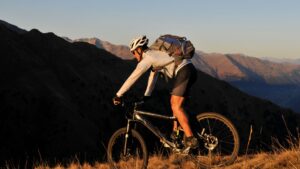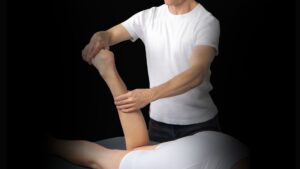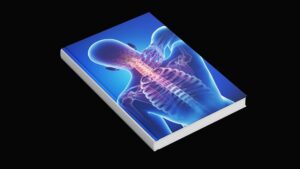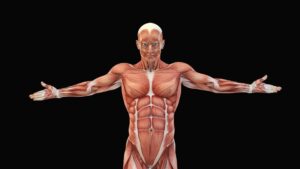The gluteus maximus was probably the muscle most responsible for pulling us up onto two legs and now look what’s happened to it. Our flexion-addicted lame-ass (no pun intended) society had forced it to be neurologically bullied about by tight hip flexors. If reciprocal inhibition doesn’t completely rob its massive power, injured SI joints and low backs certainly will. It attaches and is continuous with the biceps femoris, long dorsal SI ligaments, thoracolumbar fascia and crosses over to form the posterior spring system with latissimus dorsi (Fig 1).
The g-max and lat dorsi are not only dynamic lumbar spine stabilizers, but when working in conjunction with other spring systems, play a major role in coordinated cross-patterned gait (Fig 2).
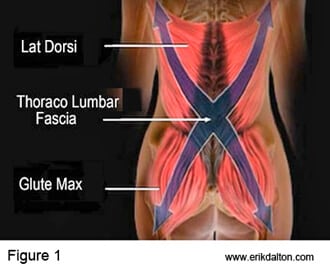
It’s easy to spot those with weak glutes. Due to reciprocal weakness, these folks tend to stand with the pelvis tilted one way or another with their butt kinda “hanging off” the hip capsules and lumbopelvic ligaments. If the muscles, tendons, and fascia are relatively weak in relation to the demands of a particular sport or repetitive activity, the vertebral joints (usually beginning with the disc) will deteriorate (Fig 3). When deterioration becomes severe it can be difficult to carry out the functions of daily living, let alone any high performance athletic endeavor. Any attempt to manually lengthen or stretch weak intrinsic and extrinsic spinal stabilizers causes greater forces to converge on the spinal discs and facets resulting in premature degeneration.
Spindle-Stim Technique
OK, so the glutes are typically weak….whadda we do about em? Even though the clients love it, the last thing we want to do is start massaging and digging around creating more stretch weakness. We could always send them to the gym for squats, leg presses, lunges, or…we could try to tonify them during the therapy session using fast-paced spindle-stimulating techniques.
Try this Spindle-Stim ‘test & treat’ routine:
• With client prone, ask them to lift their left leg as high as comfortably possible and get a sense of how high the extended leg comes off the table…then test the right.
• Place the left foot against the right knee forming a “Figure 4” position with the leg. This places g-max on the stretch.
• With arms extended, use soft fists and begin bouncing on the left hip..
• Now, drop your body weight so all the energy is coming from your legs.
• Working the tissue in all directions, begin to gradually pick up speed until you see the entire body rocking & rolling. (This is not tapotement folks…use your body weight)
• The goal is to kick in a mild stretch reflex via muscle spindle’s dynamic gamma motoneuron system..
• After two minutes of rapid spindle-stim stop and retest their degree of hip extension.
• Results are often dramatic depending on your use of the technique and the degree of weakness the client presents with.
• Repeat on the opposite side and take notes on the degree of improvement so you can test them next session to see which g-max needs more work.
What about the tight lats?
Gotta love these guys. Considered a lower quadrant muscle, lat dorsi is innervated by the cervical ganglia and instrumental in all shoulder and arm movements, i.e., chopping with an axe. Two major structural/functional problems can occur in the presence of lat hypertonicity:
• Due to their attachment at the lesser tubercle of humerus, they work with teres major and the clavicular fibers of pec major to internally rotate the humeral head leading to upper cross syndrome patterns, forward head postures and rotator cuff injuries.
• Optimal functioning of the posterior spring system during cross-patterned gait demands there be precise length/strength balance between g-max and lat dorsi. In the presence of tight lats and weak glutes, the posterior spring system fails to participate with the other spring systems to wind up the lumbar spine and propel the legs forward in the gait cycle.
Try this ‘lat-lengthening’ technique:
• The client is left sidelying, knees flexed with his/her right hand grasping the top of the therapy table.
• With your left hand behind your back, grasp the client’s right ilium and lean against your arm to brace the hip.
• Place a soft right forearm along the lateral border of the lat fascia and get a good fascial hook.
• Establish a counter-force by anchoring with your left hand and slowly hooking and gliding up the lats with your right forearm. The goal is to lift the rib cage off the pelvic girdle and open up the lateral side of the body.
• After a few strokes, stop and this time ask the client to inhale to a count of 5 while gently pulling up on the top of the therapy table.
• As they relax and exhale, hook the deeper fascia so you can really decompress lat adhesions and activate the posterior spring system.
• Repeat on opposite side.
GOAL: Help your clients maintain a strong, mobile spine and spinal spring system to minimize injuries and maximize sports performance. Advise against overexertion during competitive or recreational activities to avoid microfailure (fatigue) and eventual spinal degeneration. Remember, the spine cannot support itself without help and that’s where these spinal engine spring system routines come in handy. Restoration of optimal range of motion, length/strength balance and proper firing order are essential components of the Myoskeletal Alignment Techniques(TM).






